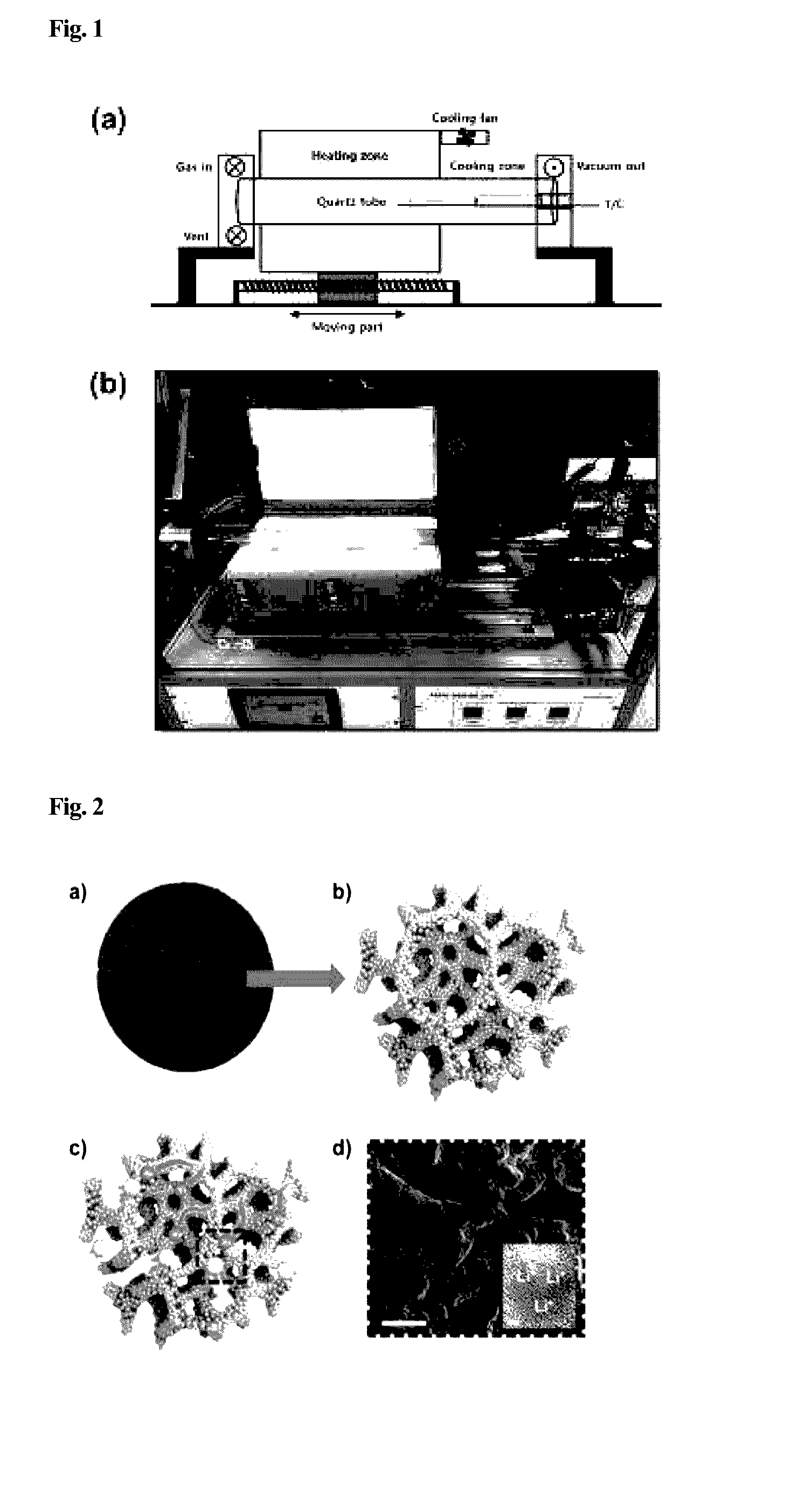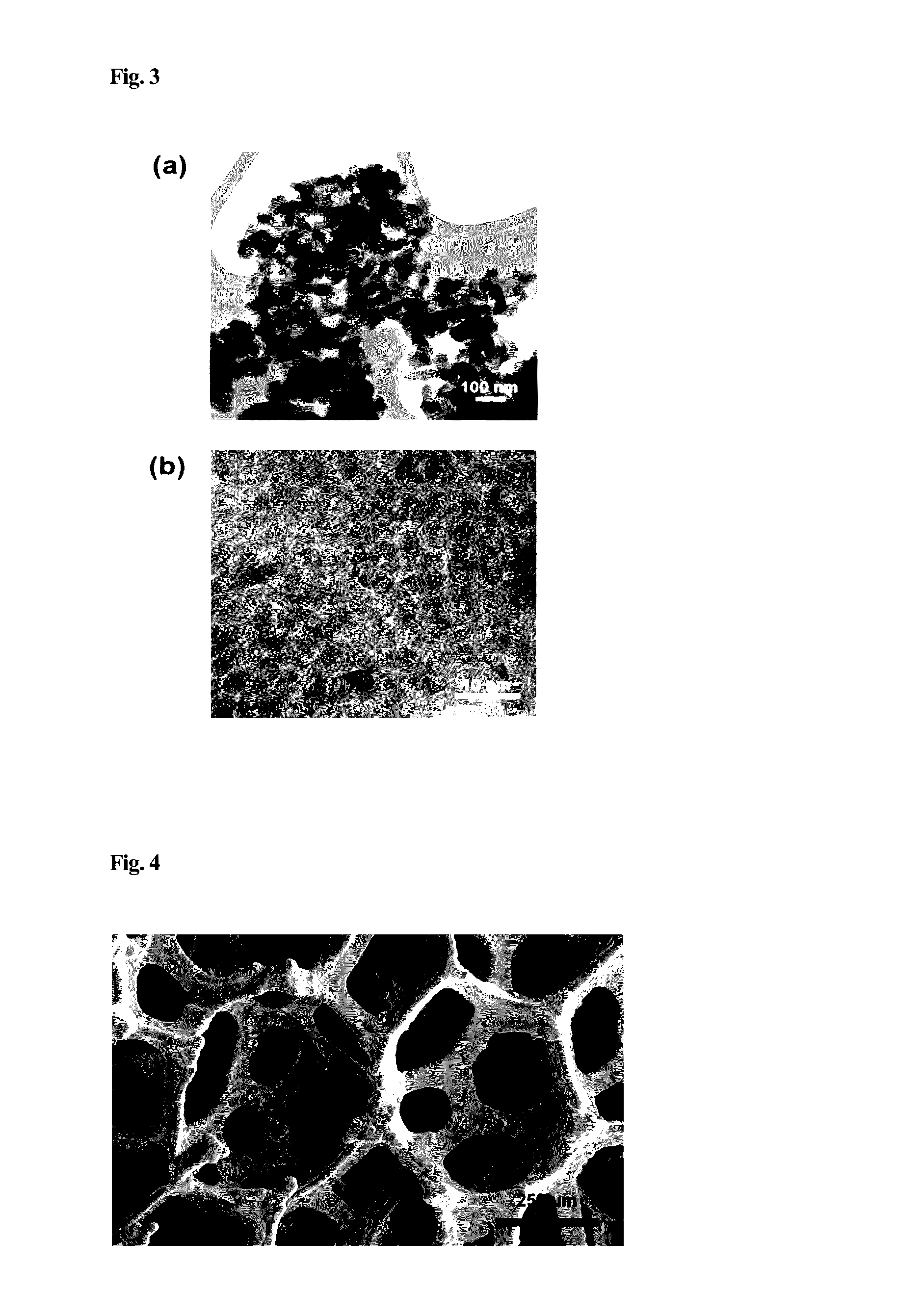Ultra-high output power and extremely robust cycle life negative electrode material for lithium secondary battery and method for manufacturing the same, using layer structure of metal oxide nanoparticles and porous graphene
a negative electrode material and lithium secondary battery technology, applied in the direction of electrode manufacturing process, cell components, electrochemical generators, etc., can solve the problems of short cycle life, inability to use above materials in some applications requiring high output power, and inability to meet conditions. , to achieve the effect of high current density condition, high conductivity and high capacity
- Summary
- Abstract
- Description
- Claims
- Application Information
AI Technical Summary
Benefits of technology
Problems solved by technology
Method used
Image
Examples
example 1
[0030]After cutting a nickel foam into a size of 0.8 cm and washing the same by using an ultrasonic disperser containing ethanol therein, the ethanol remained on the nickel foam with a nitrogen gas and the nickel foam was dried in the atmosphere. Then, a nickel catalyst was moved to a quartz tube in RTCVD shown in FIG. 1, and a sample (graphene) was placed on a sample support. After placing the sample, a chamber was under a vacuum state with a pressure of 1.0×10−3 Torr or less, and a heating zone was heated to a temperature of 900 to 1,100° C. while flowing an argon / hydrogen (500 / 200 sccm) mixed gas into the same. Next, after growing the graphene while flowing a methane gas therethrough, the heating zone was rapidly moved to its original position and cooled to a temperature of 190 to 210° C. within 4 to 6 minutes.
[0031]Thereafter, the temperature of the heating zone was raised to 900 to 1,100° C. A heater was moved to the sample support direction, in order to set up a temperature of...
example 2
[0032]Titanium dioxide nanocrystals were put in a solution including 0.1 ml of tert-butylamine, 10 ml of water, 0.1 g of Ti-propoxide, 6 ml of oleic acid and 10 ml of toluene in a PTFE-autoclave, heated at a temperature of 180° C. in an oven for 6 hours, and then, slowly cooled in the atmosphere. The supernatant only was separated from the solution, diluted several times with methanol, dried, and then, dispersed in toluene, resulting in a product in a colloidal solution state.
example 3
[0033]Titanium dioxide nanoparticles synthesized above were deposited on a graphene structure after controlling a concentration thereof by a drop-casting method. Then, the above material was heated at a temperature of 430 to 470° C. for 1 to 1.5 hours in the atmosphere, so as to deposit the nanoparticles on the graphene structure in a uniform thin film form. As described above, using a layer structure of the porous graphene and metal oxide nanoparticles, a negative electrode material for a lithium secondary battery was prepared.
PUM
| Property | Measurement | Unit |
|---|---|---|
| temperature | aaaaa | aaaaa |
| temperature | aaaaa | aaaaa |
| temperature | aaaaa | aaaaa |
Abstract
Description
Claims
Application Information
 Login to View More
Login to View More - R&D
- Intellectual Property
- Life Sciences
- Materials
- Tech Scout
- Unparalleled Data Quality
- Higher Quality Content
- 60% Fewer Hallucinations
Browse by: Latest US Patents, China's latest patents, Technical Efficacy Thesaurus, Application Domain, Technology Topic, Popular Technical Reports.
© 2025 PatSnap. All rights reserved.Legal|Privacy policy|Modern Slavery Act Transparency Statement|Sitemap|About US| Contact US: help@patsnap.com



